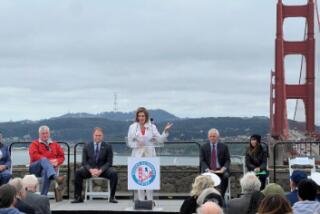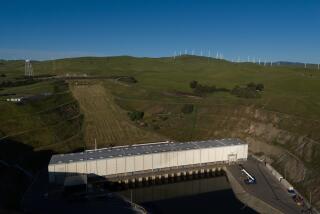A water-providing marvel â and a âdeath trapâ
Reporting from San Diego â The All-American Canal has long been known as an engineering, hydrological and agricultural marvel, delivering enormous amounts of Colorado River water to arid Imperial County and turning a desert into one of the worldâs most productive farming regions.
But in recent years, it has had another reputation: the spot where hundreds of people have drowned, most of them undocumented migrants from Mexico trying desperately to cross the canal on their way north.
By most estimates, more than 500 persons have drowned in the canal since it was completed in 1942. The peak year was 1998, when 31 persons died.
Now, after much controversy and some reluctance, the governmental owners and operators of the canal have begun a safety push along the 82-mile gravity-flow conveyance, long stretches of which parallel the border.
Carrying the message âAguas Mortales: No Mueras en el intentoâ (âDeadly Waters: Donât Die Tryingâ), posters and fliers are being distributed on both sides of the border to discourage people from attempting to cross the canal, where the current is swift and the water shockingly cold.
The fliers include a photo of a drowning victim face-down in the canal. Mexican television stations are running public-service messages with the same theme.
The Imperial Irrigation District is spending $1.1 million on the safety effort, including stringing buoy lines across the canal â every half-mile along the 23-mile lined portion and every mile along the 59-mile unlined portion. The hope is that people struggling to cross can grab one of the lines and maneuver to safety.
The canal varies in width between 150 and 200 feet and in depth from 7 to 20 feet. Lined or unlined, the sides of the canal can become slick and difficult to grasp.
At a ceremony last week outside Calexico, several agencies announced the formation of the Canal Safety Awareness Consortium. Included are the U.S. Bureau of Reclamation (which owns the canal), the Imperial Irrigation District (which runs it), the U.S. Border Patrol, the Mexican Consulate in Calexico and the San Diego County Water Authority.
âEvery immigrant saved from drowning affects a family â a family which keeps a father, a son or a brother alive,â said Alfredo Sevilla Fernandez, Mexican consul in Calexico.
John Hunter, a physicist-turned-immigrant safety activist from the San Diego area, said the buoy project is encouraging but long overdue.
âThere arenât as many [buoys] as Iâd like, but itâs something because for so many years they dragged their heels,â he said.
His nearly decade-long campaign, which included his being cited for swimming into the canal to install a demonstration buoy, was resisted by Imperial Irrigation District board.
Board membersâ âcallous attitudeâ went largely overlooked because of the areaâs remote location, Hunter said in an interview.
Finally, several media reports, culminating with a segment on CBSâ â 60 Minutes,â shamed the board into doing the right thing, he said.
The CBS segment, broadcast in May, termed the canal a âdeath trapâ and possibly the most dangerous body of water in America. In August, the Imperial Irrigation District board voted to fund the buoy project.
Hunter is the brother of former Rep. Duncan L. Hunter (R-Alpine), who served in Congress for 28 years, and the uncle of Duncan D. Hunter (also R-Alpine), who succeeded his father in 2008.
Like his brother and nephew, John Hunter believes in enforcing immigration laws. A self-described âright-wing Republican,â he is not an open-border advocate and applauds the use of cameras along the canal to alert the Border Patrol to intruders.
âI have no problem with the Border Patrol picking them up on the north sideâ of the canal, he said. âTheyâll still be alive.â
More to Read
Sign up for Essential California
The most important California stories and recommendations in your inbox every morning.
You may occasionally receive promotional content from the Los Angeles Times.











